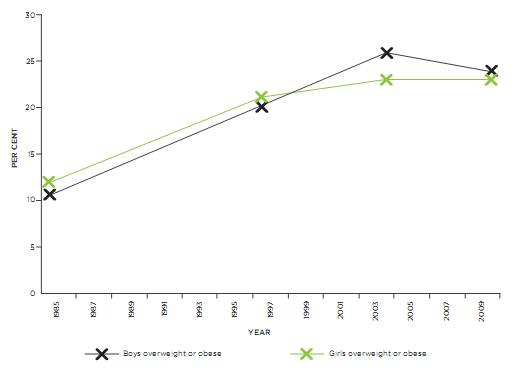Introduction
Child obesity is one of the most critical health problems in Australia. The complexity and risks of it are related to serious underlying medical consequences. In addition, childhood obesity has a significant impact on the country’s budget and has adverse effects on the expected quality of life. It is essential to analyze the data gathered from scholarly sources such as peer-reviewed journals and government publications to understand the extent and causes of the problem.
The Issue of Malnutrition
It is worth noting that the issue of child malnutrition is far from being resolved. Despite a subtle positive tendency evidenced in the statistics in Graph 1, the situation requires an immediate response from both the government and the society (NSW healthy eating and active living strategy, 2013):

Among the crucial pathogenic causes of childhood, obesity implies a number of reasons related to the environmental factors (such as poor diet, sedentary lifestyle, low socio-economic status of the family and the educational level of parents). In terms of the sociological perspective, according to statistics, more than 30% of overweight Australian children come from families with low socioeconomic status (Pescud & Pettigrew, 2014). In such families, the nutrition/physical activity system is built incorrectly and inefficiently. It is due to the low quality, type, value, and attractiveness of products available for consumption and no incentive to lead an active way of life.
Sociological Perspective of the Issue
The structural reasons associated with obesity lie in the policies of the health care industry. Typically, low-income families have limited access to government programs or are not aware of them (Barnes & Rowe, 2013). In addition, the sociological roots of obesity have a dual nature. They are connected with inadequate nutrition in the prenatal period, infancy, and early childhood followed by a high-energy diet that can be characterized by a large intake of fat, the lack of essential microelements, which is accompanied by the lack of physical activity as well.
Families with low income either do not have the possibility to buy natural and high-quality products or are unaware of balanced dieting; as a result, children opt for high carbohydrate and fatty foods (baked goods, potatoes, low-quality fats, oils). In many cases, parents do not know how to substitute products for a balanced diet correctly (Byrne, Cook, Skouteris, & Do, 2011).
One of the serious complications of childhood obesity in Australia is the difficulty in the social adaptation of the child, which is manifested in complex emotional and behavioral disorders (Lacy et al., 2015). Children may develop disorders, including depressive symptoms as a result of social rejection, discrimination, or negative stereotypes existing in the society or in the child’s environment, which leads to eating disorders (Delgado, 2013).
There are various state initiatives designed to “meet the needs of socio-economically disadvantaged communities to improve access to healthy food and assist them in eating healthily, be active and achieve and maintain a healthy weight” (NSW healthy eating and active living strategy, 2013, p. 22). However, the issue is critical, which evidences that the government should utilize such practices that would promote higher social involvement and increase awareness of people so that they would not be reluctant to participate in such programs.
In conclusion, there is an inverse relationship between the sociological aspects such as family income, parental education, nutritional patterns, and others, and the probability of occurrence of overweight or obesity in children. Consequently, the state should take drastic steps to boost the health literacy of parents, promote healthy lifestyles on the base of educational institutions, and change the perceptions and attitudes in contemporary society. As child obesity may turn into more serious health-related issues in the adult age, it is essential to address the problem prior to its occurrence or at its initial stage.
References
Barnes, M., & Rowe, J. (2013). Child, youth and family health. Sydney, Australia: Elsevier.
Byrne, L., Cook, K., Skouteris, H., & Do, M. (2011). Parental status and childhood obesity in Australia. International Journal of Pediatric Obesity, 6(5), 415-418.
Delgado, M. (2013). Social justice and the urban obesity crisis. New York, NY: Columbia University Press.
Lacy, K., Nichols, M., de Silva, A., Allender, S., Swinburn, B., Leslie, E.,…Kremer, P. (2015). Critical design features for establishing a childhood obesity monitoring program in Australia. Australian Journal of Primary Health,21, 369-372.
NSW healthy eating and active living strategy. (2013). Web.
Pescud, M., & Pettigrew, S. (2014). Treats: Low socioeconomic status Australian parents’ provision of extra foods for their overweight or obese children. Health Promotion Journal of Australia, 25(2), 104-109.